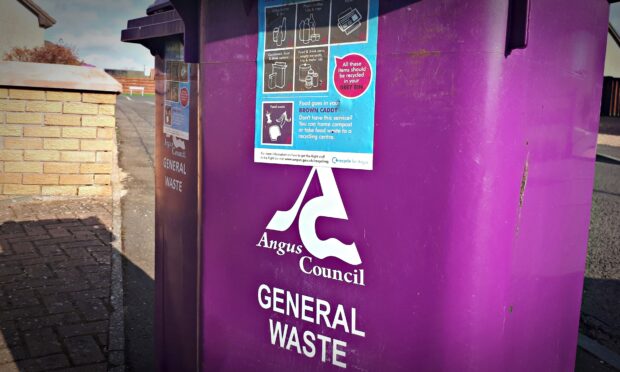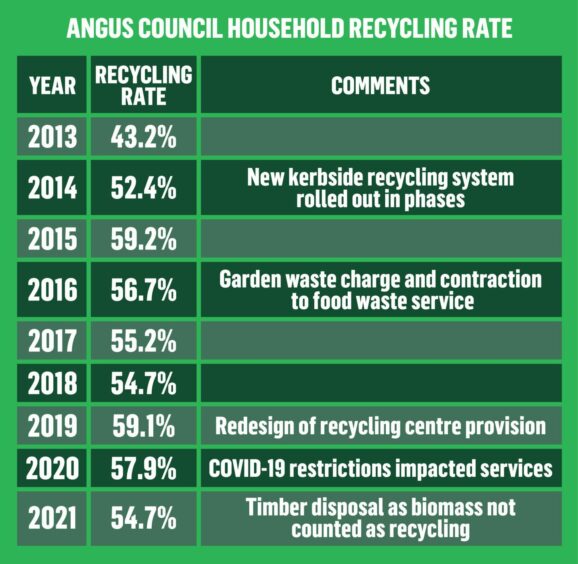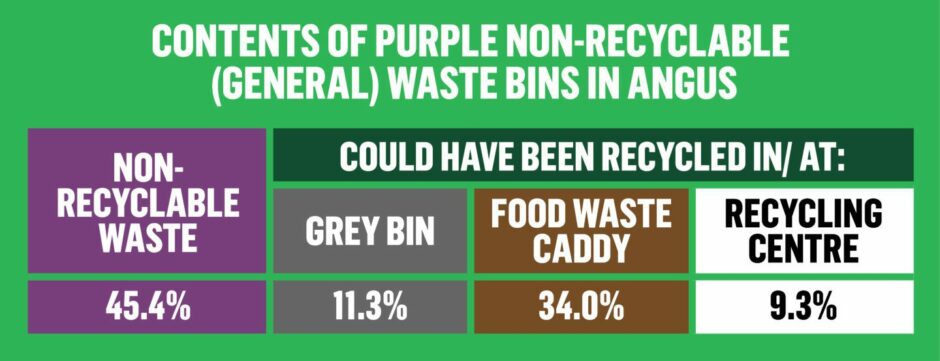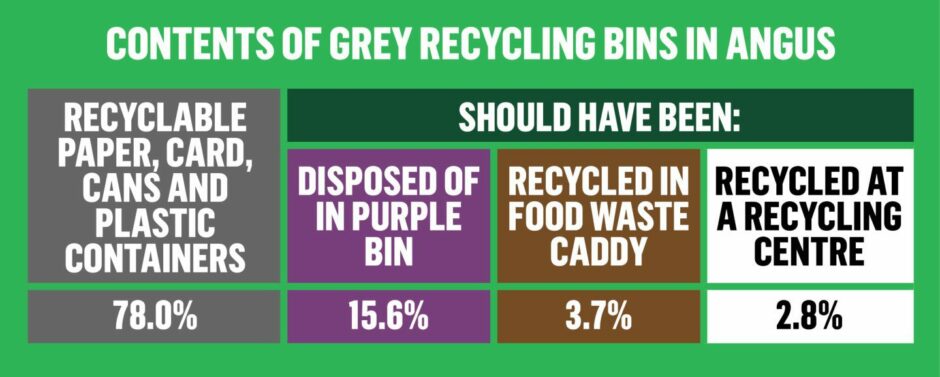Big changes for Angus bin collections are on the cards.
Next week councillors will consider plans to boost the amount of rubbish residents recycle.
It will add another recycling bin to the line up locals already have at their back door.
And folk who put too much food or recyclable rubbish into their general waste could see their bin tagged and left unemptied in a new hardline approach which is a first for a Scottish council.
A £33,000-a-year rubbish tsar would be appointed to oversee policing of the purple bin clampdown.
Glass will also have to be taken to recycling points under a scheme to bring back community bottle banks years after many were axed.
Dealing with waste which could have been recycled is costing Angus £1m a year.
Waste chiefs stress the it is a proposal at this stage.
But it is the only option on the table for communities committee councillors on Tuesday.
And a plan has been put in place to bring the changes in from 2024.
Here we look at some of the key questions behind the changes.
1 – Isn’t Angus one of the country’s top recycling councils?
Yes, the area has regularly been near the top of Scotland’s recycling league table – and is still there.
After firmly occupying a top three position for a number of years, it took the number one spot in 2020.
A recycling figure of 57.9% represented almost 30,000 tonnes of household waste being saved from landfill.
The Scottish average was 42% – neighbouring Dundee barely managed 35%.
Efforts to maintain and improve recycling rates included a controversial shake-up of skip site provision in 2019.
But budget pressures forced the closure of Kirriemuir and Monifieth recycling centres this year.
2 – So why is a major shake-up needed?
Council waste chief Graeme Dailly says change is needed to halt the decline in recycling.
“Angus is one of the better performing councils in Scotland for recycling but a ‘do nothing’ approach is likely to see a reduction in performance.”
Waste collection is the third biggest ticket item in the council’s £250m annual budget – behind education and social care.
The proposal includes buying 65,000 new blue bins for cardboard and paper only.
Those would be collected every four weeks, on alternate fortnights to the well-established grey bin which would be for plastic bottles, containers and cans.
The changes are being paid for by a £2.8m Scottish Government recycling fund grant.
The council hopes to save £1/2m a year through the new scheme, mainly through reducing waste processing costs.
3 – Why might your bin not be collected?
The changes would see Angus become the first council in Scotland to take a hardline stance against households which regularly put recyclable rubbish into their purple bin for general waste.
Contamination is a big issue for every local authority – Angus has repeatedly run the ‘Right stuff, right bin’ message.
A 2022 sample survey revealed more than half the contents of an average purple general waste bin could have been recycled.
34% was food waste which could have gone in the brown 23-litre caddy for weekly collection.
More than 10% should have been in the grey recycling bin.
Mr Dailly says: “In practice, this policy has only been applied to mixed recycling bins, garden waste bins and food waste caddies.
“While some other Scottish local authorities do have bans on putting recycling in non-recyclable waste bins, we are not aware of any applying a contamination policy in practice.
“Applying the policy will be challenging when staff can only see the top fraction of the bin they are emptying.
“It will only be applied when there is an unacceptable level of recyclables found and a procedure will be developed that aims to educate and raise awareness before bins are left unemptied.”
4 – Why is food waste so important in new scheme?
Food waste recycling has been in steady decline.
It suffered a marked reduction in 2017 when households outwith towns and villages were removed from the kerbside collection service.
Annual tonnage fell slightly each year since, until a more pronounced drop of 270 tonnes in 2022.
Food waste is around ten times less expensive to dispose of when it’s collected in the brown bin.
“Whilst there would ideally be a reduction in food waste through time due to households wasting less food, it appears that participation in the service is falling,” says Mr Dailly.
The council plans to extend the food waste service to almost 4,000 extra Angus households.
5 – What about glass?
One of the biggest changes of the new scheme would see glass banned from the grey recycling bin.
Instead, people will have to take their empties to community recycling points.
But there are currently only 23 across Angus, so the scheme proposes increasing that to 190.
Aberdeenshire Council recently changed from kerbside glass collections to recycling points which resulted in only a 4% reduction in the amount of glass collected.
6 – What do residents think of the idea?
The council carried out a community consultation late last year which drew almost 2,500 responses.
And it was the idea of bringing back glass recycling points which provoked most opposition.
- 50% disagreed with bringing their glass to a recycling point
- 82% agreed with having two recycling bins where glass continued to be collected at the kerbside
- 43% agreed with having two recycling bins and bringing their glass to a recycling point
- 49% were not willing to have their general waste bin emptied every three weeks
- 51% agreed that general waste bins containing too many recyclable items should be tagged and left uncollected
Councillors will consider the kerbside recycling scheme changes on Tuesday.
You can watch a live stream of the meeting on the council’s You Tube channel.





Conversation